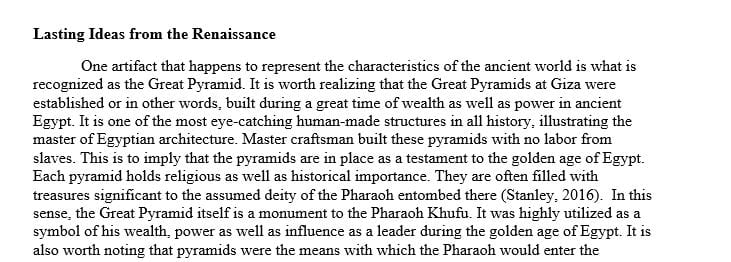Identify an artifact that represents the characteristics of each era. You should identify a total of three artifacts
Lasting Ideas From the Renaissance
In addition to the information presented this week regarding the reasons for the creation of artifacts in each era (the ancient world, the Middle Ages, the Renaissance), recall information about motives for creating artifacts presented earlier in the course as you answer these questions:
Identify an artifact that represents the characteristics of each era. You should identify a total of three artifacts. Insert an image or include a link to your artifact.
What do you believe was the purpose for the creation of each of the artifacts you selected? Justify your response using what you now know about the culture and values of each era.
Why do you believe the creators felt the need to express themselves using these artifacts?
When responding to your peers, reflect on what you have learned in this theme. What differences do you notice between the artifacts from each era? Where do you think those differences stemmed from? Do you think contemporary human creative expression can or should work to elevate humanity?
I HAVE ATTACHED THE RUBRIC & INFORMATION NEEDED FOR THSI POST.. BELOW I WILL POST 2 POSTS FROM MY CLASSMATES. PLEASE INCLUDE RESPONSES.
CLASSMATE #1 DISCUSSION POST (COURTNEY TOMES)
Ancient World
Lysistrata is a comical play written around 411 BCE to showcase the disagreement with the Peloponnesian war. The play is written about the democracy in Athens, and how women could be powerful if they stood together for their better good. However, during that time-period this idea was comical and “ridiculous”. I believe the playwright, Aristophanes, created this piece to express his personal concerns and feelings about the war, however portrayed it in a comical sense to gain attention and attraction to his piece.
Middle Ages
Everyman is a play from the Middle Ages (1530) created to teach and portray Christian morals. This morality play was created with intentions of displaying “Everyman’s” encounter with death before the final judgement” (The British Library, 2019). Throughout the play, the character tries to collect material goods and meet people to help him during his journey, only to realize it is all meaningless, and only he can get himself into Heaven. Due to religious restrictions on art in the Middle Ages, this play perfectly represents the messages and themes of Middle Aged literature.
Renaissance
In 1490, Leonardo da Vinci created the Vitruvian Man. This creation brings back the initial value of Humanities that I mentioned in my very first discussion post, “everything connects with everything”. The proportion and geometric principals were used to make a “connection between man and nature” (Totally History, 2019). Da Vinci was originally inspired by the work of Vitruvius, an ancient Roman architect, and used that inspiration to connect art with math. This piece was extremely relevant to the impact on the Renaissance, since this was the time where scientific thought and understanding of humanism exploded.
–
–
References:
Ancient-literature.com. (2019). Lysistrata – Aristophanes – Ancient Greece – Classical Literature. [online] Available at: https://www.ancient-
The British Library. (2019). Everyman, a morality play. [online] Available at: https://www.bl.uk/
Totally History. (2019). Vitruvian Man by Leonardo da Vinci – Facts & History of the Drawing. [online] Available at: http://totallyhistory.com/
CLASSMATE #2 DISCUSSION POST (ZACHERY WARNER)
The Ancient World
I chose the Teatro Marcello or the Theater of Marcellus. It was an ancient open-air theater that served as inspiration for the Colosseum. It was originally commissioned by Julius Caesar, who was murdered before its construction began, and finished by Emperor Augustus in 11BC. It was named for his nephew, Marcus Claudius Marcellus, who died five years before it was finished at the age of 19. It was a revolutionary structure at its time. With arches, tunnels, columns and ramps, it showcased the finest ancient Roman skill and artistry. The Romans were extremely knowledgeable and creative. I believe the creator succeeded in creating such a structure to withstand time and bring joy to the thousands it could hold.
The Middle Ages
I chose the Cathédrale Notre-Dame de Reims. It is a Roman Catholic cathedral in Reims, France built with a High Gothic style. The cathedral replaced an older church that was destroyed by a fire in 1211. The cathedral would hold the ceremonies where the kings of France were crowned. I believe the creators of the church constructed the cathedral to replace a pre-existing one to hold thousands of people who would come to pray. The cathedral has withstood time for 744 years. It has been depicted in many movies over the years, in my opinion the most popular one would be The Hunchback of Notre-Dame based off the French Romantic/Gothic novel by Victor Hugo which was published in 1831.
The Renaissance
I chose the Sistine Chapel ceiling which was painted between 1508-1512 by Michelangelo. The Sistine Chapel was built within the Vatican. The painting was a cornerstone work of High Renaissance art. The paintings depict scenes from the Bible, such as the creation of Adam. I believe Michelangelo’s purpose was to depict scenes from the bible and he did it so well with his artistic vision. These have lasted generations and have become one of the most popular Renaissance artifacts known to man.
Solution preview for the order on identify an artifact that represents the characteristics of each era. You should identify a total of three artifacts.

1079 words